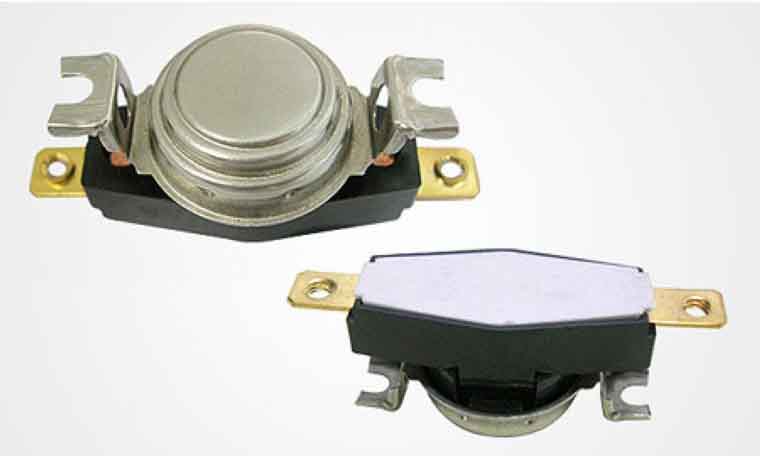Bimetal switch technical parameters and product development
1. bimetal product development
Bimetal main application products: temperature relay, thermal time delay relays, temperature switch, controller temperature, fluorescent starter, bimetal thermometer, thermometer
2. Description of the bimetal
Also known as thermal bimetal bimetal due to thermal expansion coefficient of each component layer is different, when the temperature changes, deformation of the active layer is greater than the deformation of the passive layer, so that overall the bimetal will bend to the passive layer side , the curvature of this composite material is deformed so as to change. Wherein, the higher expansion coefficient is called the active layer; a lower coefficient of expansion as the passive layer. However, with the progress of the expansion of the bimetallic applications and integration technology, modern phase has three, four, five bimetallic appear. In fact, those who rely on temperature change and shape change occurs in the composite material, now in the habit is still known as thermal bimetal.
Production of thermal bimetal material. Thermal bimetal is for relatively simple to achieve automatic control device temperature control. It consists of two layers of different thermal expansion coefficients of metal (or alloy) component. Expansion coefficient of the active layer is a layer of thermal expansion coefficient of the layer known as passive layer. Heat the bimetal, the active layer is greater than the length of the free expansion of the passive layer, but because the two layers firmly together, heat bimetal bent in an arc. On the contrary when cooled. This feature allows the manufacture thermal relay. Commonly used in the motor overload protection.

3.Materials Analysis bimetal different layers
The active layer and the active layer of thermal bimetal certain components, for example; the active layer component Mn75%, Ni15%, Cu10% or Ni20%, Mn6%, the remainder being iron, the thermal expansion coefficient in the 20 ~ 100 ℃ were 27 × 10-6 / ℃ and 20 × 10-6 / ℃; while the passive layer composition of Ni36%, the balance being iron or Ni42%, the balance being iron, the thermal expansion coefficient (1.8 ~ 4.8) × 10-6 / ℃. The method of combining heat bimetal cold-rolled binding, fusion bonding, hot-rolled binding and the like.
Thermal bi-metallic materials can be divided into six kinds.
① Universal: suitable for a variety of uses and a medium temperature range, high sensitivity and strength.
② high temperature: suitable for operation above 300 ℃, has high strength and good oxidation resistance.
③ low temperature: is adapted to operate below 0 ℃.
④ resistance: with the high and low resistivity are available for a variety of small, standardized electrical appliances.
⑤ sensitivity type: high sensitivity, high resistance and other characteristics.
⑥ corrosion resistant: a good corrosion resistance, suitable for the role in the corrosive medium.
Bimetal main application products: temperature relay, thermal time delay relays, temperature switch, controller temperature, fluorescent starter, bimetal thermometer, thermometer
2. Description of the bimetal
Also known as thermal bimetal bimetal due to thermal expansion coefficient of each component layer is different, when the temperature changes, deformation of the active layer is greater than the deformation of the passive layer, so that overall the bimetal will bend to the passive layer side , the curvature of this composite material is deformed so as to change. Wherein, the higher expansion coefficient is called the active layer; a lower coefficient of expansion as the passive layer. However, with the progress of the expansion of the bimetallic applications and integration technology, modern phase has three, four, five bimetallic appear. In fact, those who rely on temperature change and shape change occurs in the composite material, now in the habit is still known as thermal bimetal.
Production of thermal bimetal material. Thermal bimetal is for relatively simple to achieve automatic control device temperature control. It consists of two layers of different thermal expansion coefficients of metal (or alloy) component. Expansion coefficient of the active layer is a layer of thermal expansion coefficient of the layer known as passive layer. Heat the bimetal, the active layer is greater than the length of the free expansion of the passive layer, but because the two layers firmly together, heat bimetal bent in an arc. On the contrary when cooled. This feature allows the manufacture thermal relay. Commonly used in the motor overload protection.

3.Materials Analysis bimetal different layers
The active layer and the active layer of thermal bimetal certain components, for example; the active layer component Mn75%, Ni15%, Cu10% or Ni20%, Mn6%, the remainder being iron, the thermal expansion coefficient in the 20 ~ 100 ℃ were 27 × 10-6 / ℃ and 20 × 10-6 / ℃; while the passive layer composition of Ni36%, the balance being iron or Ni42%, the balance being iron, the thermal expansion coefficient (1.8 ~ 4.8) × 10-6 / ℃. The method of combining heat bimetal cold-rolled binding, fusion bonding, hot-rolled binding and the like.
Thermal bi-metallic materials can be divided into six kinds.
① Universal: suitable for a variety of uses and a medium temperature range, high sensitivity and strength.
② high temperature: suitable for operation above 300 ℃, has high strength and good oxidation resistance.
③ low temperature: is adapted to operate below 0 ℃.
④ resistance: with the high and low resistivity are available for a variety of small, standardized electrical appliances.
⑤ sensitivity type: high sensitivity, high resistance and other characteristics.
⑥ corrosion resistant: a good corrosion resistance, suitable for the role in the corrosive medium.
| Bimetal different grades of technical parameters | |||||||||||||||||||||||||||||||||||||||||||||||||||||||||||||||||||||||||||||||||||||||||||||||||||||||||||||||||||||||||||||||||||||||||||||||||||||||||||||||||||||||||||||||||||||||||||||||||||||||||||||||||||||||||||||||||||||||||||||||||||||||||||||||||||||||||||||||||||||||||||||||||||||||||||||||||||||||||||||||||||||||||||||||||||||||||||||||||||||||||||||||||||||||||||||||
|
|||||||||||||||||||||||||||||||||||||||||||||||||||||||||||||||||||||||||||||||||||||||||||||||||||||||||||||||||||||||||||||||||||||||||||||||||||||||||||||||||||||||||||||||||||||||||||||||||||||||||||||||||||||||||||||||||||||||||||||||||||||||||||||||||||||||||||||||||||||||||||||||||||||||||||||||||||||||||||||||||||||||||||||||||||||||||||||||||||||||||||||||||||||||||||||||





